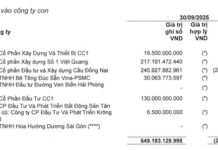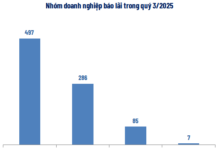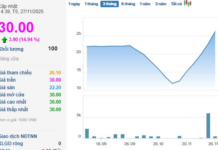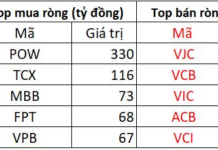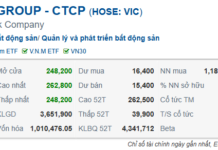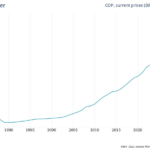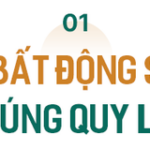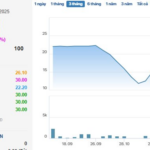
Signs of the private sector “running out of steam”. Photo: LE VU |
A Picture of Two Contrasting Colors
In developed countries, the driving force behind building, innovating, and promoting the sustainable growth of the entire economy lies in the private sector. As Vietnam aims to become a high middle-income country by 2030 and a high-income country by 2045, it will be no exception to this rule.
According to a study by the Australian Government (2014), the private sector accounts for 90% of employment, finances over 60% of investment in developing countries, and contributes more than 80% to the budget. Another study by the European Commission (2017) found that the contribution of the private sector to GDP and employment in developing countries was 84% and 90%, respectively.
The role and contribution of Vietnam’s private sector are much more modest. According to the General Statistics Office, by 2024, the private sector is expected to account for 53.4% of total social investment capital, contribute 43% to GDP, and employ 82.07% of the total labor force. Looking on the bright side, there is still significant potential and room for growth in Vietnam’s private sector, especially considering its outstanding growth rate compared to other sectors. According to a study by the National Economics University, during the 2011-2023 period, the number of private enterprises increased by an average of 14.7% per year; investment capital scale increased by an average of 25.3% per year; and the labor force increased by an average of 8% per year. The respective average figures for the whole country are only 10%, 21.9%, and 5.1%.
Along with the increase in the scale of resource factors, during the aforementioned period, the revenue growth rate of the private sector averaged 13.5% per year, significantly higher than that of state-owned enterprises (6.1%).
However, the study “Unraveling the Constraints in Private Sector Development to Achieve Double-Digit Growth” by the National Economics University candidly pointed out signs of the private sector “running out of steam.” It indicated that the growth rate of enterprises, revenue, investment, and labor from 2016 onwards tends to slow down compared to the 2011-2015 period. Additionally, there is a growing trend of enterprises not wanting to expand, and the phenomenon of private enterprises ceasing operations or declaring bankruptcy has been on the rise in recent years, with a 50% rate of private enterprises not surviving beyond their second year.
Evidently, there are bottlenecks hindering the proportional development of the private sector in Vietnam. Within the scope of this study, economists have identified these constraints and proposed solutions that deserve thoughtful consideration.
Where is the Bottleneck?
Apart from shortcomings in the perception of the private sector’s role and the lack of comprehensiveness in policy frameworks, the research group led by Prof. Ngo Thang Loi (National Economics University) pointed to another critical bottleneck. Vietnam has yet to establish an appropriate and effective model to unite the constituent parts of its private sector.
|
Vietnam lacks an appropriate and effective model to unite the constituent parts of its private sector. |
Firstly, large-scale private enterprises (economic groups) have not proactively assumed their leading role in the multi-layered development model of Vietnam’s private enterprises. In their orientation and implementation of development strategies, these economic groups have yet to adopt business strategies centered on developing source technology industries or upstream manufacturing industries. Consequently, there is a lack of complete domestic supply chains, which are the foundation for implementing business linkages.
Moreover, economists pointed out that in their “mission” or “vision,” these economic groups have not prioritized the establishment and development of chains or networks of production under their leadership. As a result, there are no production chains or networks linking large enterprises with small and medium-sized enterprises within the private sector.
Meanwhile, small and medium-sized enterprises lack the prerequisites to engage in business linkages with large-scale enterprises in the private sector and other economic sectors. They face challenges such as minuscule scale, inadequate human resources, finances, technology, production techniques, management skills, and research and development capabilities. Their business operations tend to be short-term, focusing primarily on service industries, small-scale production and trading, low capital volume, and subpar quality. The network of enterprises is also too thin to act as intermediaries and connect small and micro-enterprises into the orbit.
Additionally, we have not established a model for linking businesses and overseas Vietnamese with the domestic private sector’s business activities.
Two Linkage Models
The research group from the National Economics University proposed two models to unite the Vietnamese private sector. The first is a linkage model among different types of domestic private enterprises, creating a “trickle-down effect.” In this model, private economic groups, state-owned economic groups, and economic groups with foreign investment directly approach the market and commercialize products.
To achieve product synchronization on a large scale, these groups establish direct or indirect links with other parts of the private sector. This linkage can take various forms, such as production value chain linkage, circular business linkage, cooperative linkage, supply and product exchange contracts, or social impact-oriented business models. As a result, business performance and development trickle down from the top to the bottom. To join this chain, small and medium-sized enterprises, micro-enterprises, and households must fundamentally transform their business strategies, positioning themselves within the product supply chain for larger enterprises or taking on research and development to create new products.
The second model involves organizing linkages between overseas Vietnamese enterprises and domestic private enterprises, along with strengthening the role of business associations at home and abroad. In this model, private enterprises owned by overseas Vietnamese have advantages in product markets, investment capital, technology, and modern production and business equipment. Domestic private enterprises and localities have advantages in raw material sources, production bases, and labor forces. By cooperating and complementing each other, the two sides can contribute to a more robust Vietnamese private sector.
By Khanh Nguyen
The Vietnamese Economy Over 80 Years: The 1986 ‘Major Surgery’ and the Historic Decision for a ‘Second Renovation’
According to economic expert Nguyen Bich Lam, if the 1986 renovation was considered a vital choice to rescue the economy, then the “second renovation” in 2025 and beyond is a prerequisite for Vietnam to fulfill its aspiration of rapid and sustainable development.
“Prime Minister Directs Exploration of a Private Sector Development Fund and the Creation of a Business Environment Index”
“During a meeting with the Private Economic Development Research Board, Prime Minister Pham Minh Chinh urged the swift establishment of a Private Economic Development Fund and the creation of an evaluation index for the implementation of Resolution 68-NQ/TW. These initiatives are designed to boost the private sector’s role as a vital driver of economic growth.”
“Vingroup Completes a Top-10 World Wonder in Just 10 Months: The Power of Private Enterprise in Achieving the Unimaginable.”
Reviewing the recent transformations within the private economic sector, renowned economist Pham Chi Lan emphasized, “The most evident transformation that society witnesses is the bold initiative taken by a multitude of prominent private enterprises. These enterprises have actively engaged in key projects, ranging from central to local initiatives.”
“High Interest Rates on Short-Term Deposits: Implications for Vietnam’s Economy”
The private sector in Vietnam is currently dominated by banking and real estate enterprises. This, according to Dr. Le Xuan Nghia, former Vice Chairman of the National Financial Supervisory Commission, is an inevitable phase of accumulation that many nations have gone through on their path to industrialization and the development of science and technology.











